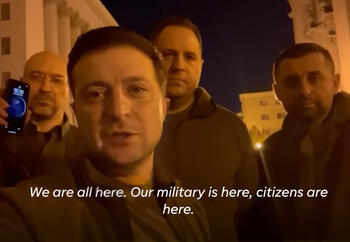
Like all physical conflicts, the current war in Ukraine is also an ongoing war of narratives, in this case one making heavy use of visual imagery. As they have played out, the threads of these narratives have a telling sequence of their own, revealing the tragic arc of most wars as they confront the ultimate—and ultimately gendered and classed—victims of modern warfare: women, children, the elderly, the poor and working classes.
War narratives do not open with such storylines of course, and this conflict is no different. Before the first shot was fired, the West provided satellite images of Russian’s early military buildup along Russian and Belarussian borders. It was an interesting strategy, a visual foretelling that put Russia in a defensive position from the first, establishing a story-line that made its military moves seem predictable and almost robotic, a product of earlier Soviet mismanagement.
Without dismissing in the least the admirable resilience and capabilities of the outnumbered and outgunned Ukrainian forces, it is important to recognize a key motif in this storyline that is part of Western mythos: individualism over collectivity. In this narrative thread, the unified front displayed by Ukrainian forces is not entirely overlooked. Rather, stress is laid on the failure of Russia’s military to properly delegate authority, a theme long-stressed in Western narratives opposed to collectivity in general.
On the heels of that media opening, another key thread has been built, one allied with an ethos of individualism as embodied in a regular aspect of most narrative: key characters. Not surprisingly, the most significant characterizations to date are of the war’s primary protagonist/antagonist figures: Volodymyr Zelensky and Vladimir Putin. As the war’s central hero/villain figures (no matter which side the story is told from) they embody key class and gender distinctions, but with an ironic yet important reversal in storylines.
Putin’s early public persona has shifted over time as he has morphed from shirtless romance hero to suited executive, a role more in keeping with both his age and his current role. The infamous pre-war photo of germaphobe Putin and French President Emmanuel Macron, separated by a 20-foot-long table, only enunciates Putin’s splendid isolation. The setting, which hearkens back not to a socialist state but to Tsarist excess and luxury, underscores his current persona.

As was made clear from the viral vignette of his dressing-down of the Head of Russian Intelligence, Putin now embodies the role of an ironically Western, Apprentice-like corporate executive and member of a masculinist elite—albeit one with nuclear weapons and a penchant for murdering his opponents.
Contrast Putin’s autocratic put-down with the now-famous selfie video of Zelensky and his cabinet refusing to leave downtown Kyiv. In occupying the foreground of this informal video Zelensky is not attempting to establish his singularity or dominance (photo above). Rather he is one among equals, visually embodying group cohesion.
At the same time, Zelensky’s visual placement among this band of brothers is augmented by his delivery of what are admittedly formal but nevertheless powerful lines. As his fixed, hand-held phone captures the small group, Zelensky quietly repeats “tut/tyt”: “here,” “here,” “here” while he names each individual cabinet member, thus solidifying the group’s physical and metaphorical placement together and among the inhabitants of Kyiv.
Read the rest of this piece at Working-Class Perspectives.
James V. Catano is producer/director of Enduring Legacy: Louisiana’s Croatian Americans and author of Ragged Dicks: Masculinity, Steel, and the Rhetoric of the Self-Made Man. He is Professor Emeritus of English and Screen Arts at Louisiana State University.












